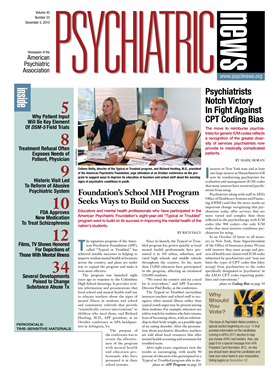How could well-meaning, highly educated mental health clinicians create a pattern of care that appears to be discriminatory?
For the last five years, Margarita Alegria, Ph.D., and colleagues have recorded and deconstructed doctor-patient encounters seeking answers to that question.
“Treatment depends on patients' description of their own symptoms and on nonverbal cues they present, and both are socially constructed,” said Alegria at the APA Institute on Psychiatric Services in Boston in October.
At the same time, the clinician's ability to comprehend patients' language, symptoms, and emotions is also filtered through his or her own cultural perspective.
“The interaction is a translation of a translation,” said Alegria, a professor of psychology in the Department of Psychiatry at Harvard Medical School and director of the Center for Multicultural Mental Health Research at Cambridge Health Alliance. “It's no wonder people get lost in that translation.”
Those cultural fault lines can interfere with diagnosis and treatment and determine whether a patient feels willing to return for follow-up care.
The disconnection can occur when a clinician, pressed for time, resorts to shortcuts. Looking at a particular patient, the clinician recalls previously encountered patients identified with the same group—blacks, whites, Asians, or Latinos, for example. Conscious or not, that practice leads to systematic bias in data collection and interpretation, said Alegria.
Her study was based on 129 videos of first office visits to 47 health care clinicians. The visits were followed by separate postdiagnostic interviews with patients and clinicians and with chart reviews. The patients were mostly low-income African Americans, whites, and Latinos, while 66 percent of the clinicians were white.
The researchers concluded that five mechanisms seemed to explain how the patient-clinician pairs interacted.
First, cultural dissimilarities between patient and clinician appeared to limit diagnostic assessment, said Alegria. Overall, the clinicians asked only one-third of these dissimilar patients about the most basic DSM-IV criteria.
“Many patients mentioned symptoms, but the providers didn't follow through and ask probing questions.” They also asked different questions depending on a patient's race or ethnicity.
For instance, Latinos were asked fewer questions about substance use than whites were, but received more questions about depression than were asked of either whites or blacks.
Second, 82 percent of the clinicians mentioned using intuition in diagnosing or treating a patient. They used words such as “gut,” “experience,” or “just knowing” to describe how they arrived at conclusions about a patient's condition.
The third mechanism at work in these encounters involved communications, which varied with the ethnicity pairing. When both patient and clinician were Latinos, for example, questions were more likely to include “partnership and activating statements,” such as “What do you think?”
When both were white, there was more joking, which was not seen in the Latino pairs. Relatively more biomedically oriented questions came up in the white dyads than in the Latino ones. When ethnicity of the clinician and patient was mixed, small talk about weather or sports was more frequent.
The fourth mechanism was stereotyping, which occurred in both directions, Alegria noted. In follow-up interviews, the patients overestimated the age, income, and educational standing of the clinicians and misjudged their marital status, while clinicians often underestimated the socioeconomic status of their patients. Each transferred stereotypes about the other's group to the individual.
A lack of cultural awareness also prevents understanding of differences, said Alegria. Patients want doctors who listen, spend time with them, pay attention to their needs, and manage the cultural differences.
“Listening,” though, is not the same for all. Blacks in her study indicated that listening meant respecting the patient as an expert on himself or herself. For whites, it meant feeling comfortable enough to express their feelings to the clinician.
For Latinos, it meant following the patient's story, not asking the same question repeatedly, and paying attention to the individual by maintaining eye contact and providing other nonverbal cues confirming a focus on the patient.
Based on discussions with the patients and clinicians in her study, Alegria offered preliminary recommendations for training clinicians in diagnosing and treating patients of diverse backgrounds.
“First, make providers more uncertain about the use of intuition in patient encounters,” she said. “Encourage them to be more self-reflective as well.”
To those ends, she suggests using videotapes of doctor-patient encounters for later analysis, but not only by the clinicians. Ask patients to review the videos, too, and ask them when they felt connected to the therapist and when they did not, she said.
Ultimately, since the mental health workforce is so small relative to the need, and the patient population is becoming ever more diverse, perfectively matching provider and patient race or ethnicity is unlikely. If patients and clinicians can, however, make adjustments in their perceptions of groups different from their own, their encounter may prove to be a much more productive therapeutic experience than is now often the case, she said.


